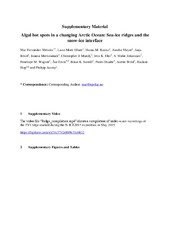| dc.contributor.author | Fernández-Méndez, Mar | |
| dc.contributor.author | Olsen, Lasse Mork | |
| dc.contributor.author | Kauko, Hanna M. | |
| dc.contributor.author | Meyer, Amelie | |
| dc.contributor.author | Rösel, Anja | |
| dc.contributor.author | Merkouriadi, Ioanna | |
| dc.contributor.author | Mundy, Christopher John | |
| dc.contributor.author | Ehn, Jens K. | |
| dc.contributor.author | Johansson, Malin | |
| dc.contributor.author | Wagner, Penelope Mae | |
| dc.contributor.author | Ervik, Åse | |
| dc.contributor.author | Sorrell, BK | |
| dc.contributor.author | Duarte, Pedro | |
| dc.contributor.author | Wold, Anette | |
| dc.contributor.author | Hop, Haakon | |
| dc.contributor.author | Assmy, Phillipp | |
| dc.date.accessioned | 2018-04-24T08:23:46Z | |
| dc.date.available | 2018-04-24T08:23:46Z | |
| dc.date.issued | 2018-03-12 | |
| dc.description.abstract | During the N-ICE2015 drift expedition north-west of Svalbard, we observed the establishment and development of algal communities in first-year ice (FYI) ridges and at the snow-ice interface. Despite some indications of being hot spots for biological activity, ridges are under-studied largely because they are complex structures that are difficult to sample. Snow infiltration communities can grow at the snow-ice interface when flooded. They have been commonly observed in the Antarctic, but rarely in the Arctic, where flooding is less common mainly due to a lower snow-to-ice thickness ratio. Combining biomass measurements and algal community analysis with under-ice irradiance and current measurements as well as light modeling, we comprehensively describe these two algal habitats in an Arctic pack ice environment. High biomass accumulation in ridges was facilitated by complex surfaces for algal deposition and attachment, increased light availability, and protection against strong under-ice currents. Notably, specific locations within the ridges were found to host distinct ice algal communities. The pennate diatoms Nitzschia frigida and Navicula species dominated the underside and inclined walls of submerged ice blocks, while the centric diatom Shionodiscus bioculatus dominated the top surfaces of the submerged ice blocks. Higher light levels than those in and below the sea ice, low mesozooplankton grazing, and physical concentration likely contributed to the high algal biomass at the snow-ice interface. These snow infiltration communities were dominated by Phaeocystis pouchetii and chain-forming pelagic diatoms (Fragilariopsis oceanica and Chaetoceros gelidus). Ridges are likely to form more frequently in a thinner and more dynamic ice pack, while the predicted increase in Arctic precipitation in some regions in combination with the thinning Arctic icescape might lead to larger areas of sea ice with negative freeboard and subsequent flooding during the melt season. Therefore, these two habitats are likely to become increasingly important in the new Arctic with implications for carbon export and transfer in the ice-associated ecosystem. | en_US |
| dc.description | Source at <a href=https://doi.org/10.3389/fmars.2018.00075> https://doi.org/10.3389/fmars.2018.00075. </a> | en_US |
| dc.identifier.citation | Fernández-Méndez, M., Olsen, L. M., Kauko, H. M., Meyer, A., Rösel, A., Merkouriadi, I. ... Assmy, P. (2018). Algal hot spots in a changing Arctic Ocean: Sea-ice ridges and the snow-ice interface. Frontiers in Marine Science. 5(75) | en_US |
| dc.identifier.cristinID | FRIDAID 1558497 | |
| dc.identifier.doi | 10.3389/fmars.2018.00075 | |
| dc.identifier.issn | 2296-7745 | |
| dc.identifier.uri | https://hdl.handle.net/10037/12583 | |
| dc.language.iso | eng | en_US |
| dc.publisher | Frontiers Media | en_US |
| dc.relation.journal | Frontiers in Marine Science | |
| dc.relation.projectID | info:eu-repo/grantAgreement/RCN/POLARPROG/244646/NORWAY/Ice-algal and under-ice phytoplankton bloom dynamics in a changing Arctic icescape// | en_US |
| dc.relation.projectID | info:eu-repo/grantAgreement/RCN/NORRUS/233896/NORWAY/Detection and Characterization of Anthropogenic Oil Pollution in the Barents Sea by Synthetic Aperture Radar// | en_US |
| dc.relation.projectID | info:eu-repo/grantAgreement/RCN/SFI/237906/NORWAY/Centre for Integrated Remote Sensing and Forecasting for Arctic Operations/CIRFA/ | en_US |
| dc.rights.accessRights | openAccess | en_US |
| dc.subject | arctic ecosystem | en_US |
| dc.subject | ice algae | en_US |
| dc.subject | phytoplankton | en_US |
| dc.subject | infiltration communities | en_US |
| dc.subject | sea-ice ridges | en_US |
| dc.subject | community composition | en_US |
| dc.subject | climate change | en_US |
| dc.subject | VDP::Matematikk og Naturvitenskap: 400::Zoologiske og botaniske fag: 480::Marinbiologi: 497 | en_US |
| dc.subject | VDP::Mathematics and natural science: 400::Zoology and botany: 480::Marine biology: 497 | en_US |
| dc.title | Algal hot spots in a changing Arctic Ocean: Sea-ice ridges and the snow-ice interface | en_US |
| dc.type | Journal article | en_US |
| dc.type | Tidsskriftartikkel | en_US |
| dc.type | Peer reviewed | en_US |


 English
English norsk
norsk
